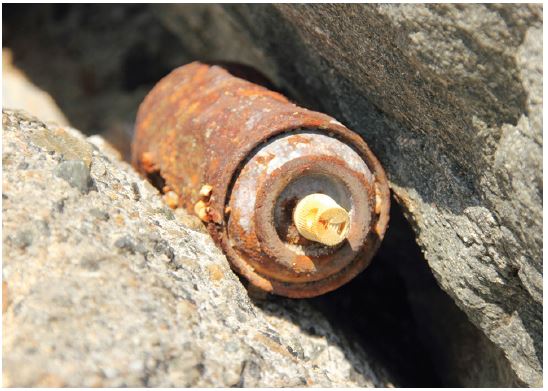Written on: August 1, 2022 by W. Stephen Tait
Hello everyone. Why abandon a formula if it causes package corrosion? I suspect most wouldn’t because corrosive formulas sometimes have the most desirable performance among those evaluated for a particular product type.
Indeed, most will typically try to find a corrosion inhibitor before giving up on a corrosive formula. In my 50 years of working with a variety of corrosion issues, I’ve only encountered one situation where a corrosive formula couldn’t be transformed from a package-eater into a commercial product with a suitable package service lifetime.
Any formula that contains water as an ingredient (or can be contaminated with water) could cause corrosion of package metal and polymer. Of course, most spray products contain some water, thus most formulas probably either have, or need, a corrosion inhibitor.
Corrosion inhibitors are an effective way to control package corrosion. The amount of inhibitor needed is often significantly less than 1%, making corrosion inhibition a cost-effective way to control package corrosion, as well.
However, finding or developing a corrosion inhibitor can be a frustrating process. There are literally thousands of chemicals that have been used or touted as corrosion inhibitors for a wide variety of situations.
Over the years, I’ve received questions about corrosion inhibitors that can be generalized as follows:
• Where can I find a list of corrosion inhibitor suppliers? (The SPRAY Technology & Marketing Buyers Guide lists companies that sell corrosion inhibitors)
• Is there a list of corrosion inhibitors for the various types of consumer spray products?
• How do corrosion inhibitors work in general?

Most corrosion inhibitors are developed for specific formulas and environments. Many corrosion-inhibited formulas are patented and others are company trade secrets that are not available for widespread use. Indeed, most of the corrosion inhibitors I’ve developed are trade secrets that cannot be disclosed or published.
The discussion of corrosion inhibitors is very complex and cannot be covered completely here; however, we’ll provide an overview on the science and practice of corrosion inhibitors.
Overview
Most metals are found naturally as metal oxides (gold and silver are examples of exceptions). It takes a significant amount of energy to refine oxides into metals, and they have a very strong tendency to return to their original oxide form by corroding.
Coatings and laminate films hinder the progress of corrosion; however, the effect is not permanent and sometimes not long enough to achieve the targeted package service lifetime. To make matters worse, there are numerous electrochemically-active molecules (e.g., water) and ions (e.g., hydrogen ions)—collectively called EACs—that, when in a formula, help the package metal in its effort to return to its former oxidized state by corroding.
In short, corrosion inhibitors interfere with this natural process of the metal returning to its oxidized state. In addition, some corrosion inhibitors also prevent EACs from coming into contact with the package metal and coated package metals.
There are several different ways in which corrosion inhibitors prevent EACs from causing metal corrosion. Inhibitors can:
• Adsorb on active sites where metal-electrons could transfer to EACs in a formula
• Form a film that hinders EACs from reaching the package metal
• Oxidize the package metal to form a passive metal-oxide layer that hinders corrosion
Effectiveness
Corrosion inhibitors most often only work for one specific chemical composition. For example, one of my patents (U.S. Patent No. 4,668,507: Corrosion Resistant Insecticidal Composition) covers an inhibitor system for aqueous dursban aerosol insecticides. In this case, the patented inhibitor is a mixture of sodium benzoate and sodium dihydrogen phosphate in a specific range of ratios. This inhibitor combination was very effective in preventing uncoated tinplate package corrosion by aqueous dursban insecticide formulas, but it rarely worked for hundreds of other corrosive non-dursban formulas. I’ve also seen numerous instances where formulas that contain sodium benzoate or sodium nitrite were corrosive.
The important issues to keep in mind are:
• A specific inhibitor is often only effective for a specific formula composition
• No single corrosion inhibitor will inhibit package metal corrosion for all possible formula compositions
• An inhibitor is often only effective within a specific range of concentrations
• A specific mixture of corrosion inhibitors is often only effective with a specific range of mixture ratios
Is there a list of corrosion inhibitors?
Most commercial inhibitor formulas are trade secrets or patented. Consequently, you won’t find a public, comprehensive list of corrosion inhibitors for every type of consumer spray product (i.e., use inhibitors A or B for air fresheners; use inhibitors C and D for hair sprays, etc.).
Patented inhibitor formulas can only be used by the owner during the lifetime of the patent. Using a patented formula without a license from the owner typically results in a threatening letter from an attorney, or worse, expensive litigation.
Over the years, I’ve been shown a few compiled lists of corrosion inhibitors without reference to the formulas or environments for which they were used. These lists typically have chemicals that are:
• Not corrosion inhibitors (e.g., tin oxide)
• Toxic chemicals (often ones that are carcinogenic, such as morpholine)
• Corrosion inhibitors for the petrochemical and chemical industries (these are also usually toxic)
• Corrosion inhibitors that work only for one specific product
The SPRAY Technology & Marketing Buyers Guide provides a list of companies that sell corrosion inhibitors. However, the effectiveness for each type of inhibitors should be evaluated before using them in specific commercial formulas.
Thanks for your interest in Corrosion Corner and I’ll see you in September.
Contact me at 608-831-2076; rustdr@pairodocspro.com or from our two websites: pairodocspro.com and aristartec.com. SPRAY